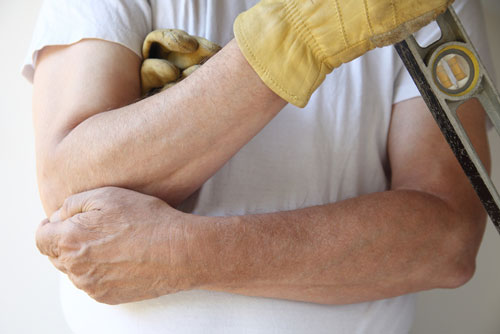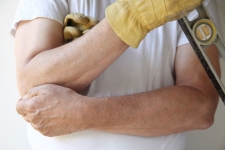
Tennis elbow, aka lateral epicondylitis, affects the tendon that runs along the outside of the elbow and is caused by playing racquet sports or working in a variety of professions that involve repetitive arm movements. Symptoms include pain or burning along the outside of the elbow, as well as problems with gripping items. This particular ailment tends to improve with rest, physical therapy, or the use of a brace.
Now, medial epicondylitis, or golfer’s elbow (also called little leaguer’s elbow when it occurs in children), affects the tendons that run along the inside of the elbow and is caused by the repetitive throwing motion that’s seen in baseball, or the downward swing of a golf club. Medial epicondylitis causes pain along the inside of the elbow that is particularly noticed with wrist movements. This condition typically improves with conservative treatment methods, such as rest, ice, and anti-inflammatory medications, such as ibuprofen.
Olecranon bursitis – often called “student’s elbow” – affects the bursa (small sac of fluid that helps to protect and lubricate the joint) that is responsible for protecting the “pointy” portion of the elbow. It can be caused by leaning on the elbow for an extended period of time, a blow to the joint (like hitting your elbow on a doorframe), or other conditions like arthritis or infection. Symptoms include pain, swelling, and difficulty with elbow mobility. This particular ailment can be treated by wearing elbow pads or taking medication; in severe and/or chronic cases, surgery may be necessary.
Fractures (a crack or break in the bone) and dislocations (when a bone has been moved from its usual position) occur when there’s an injury to the elbow, like falling on an outstretched arm. Symptoms include obvious deformity of the elbow, pain, swelling, discoloration (bruising), and an inability to move the joint. A dislocation can be relieved by having a medical professional move the bone back into place, and may be splinted or casted in the same manner as a fracture would be. Physical therapy is often prescribed to help with range of motion restoration post splint/cast removal.
Sprains and strains can be due to either a traumatic injury or repeated stress on the joint, and sometimes a “popping” noise can be heard upon injury. Symptoms include pain, swelling, joint instability and decreased range of motion. Treatment involves rest, pain relief, icing, bracing, and physical therapy.
Due to the fact that many elbow afflictions occur as a direct result of overuse or injury, many can be prevented by working to correct improper sports techniques, using a proper sized grip – and grip tension – on sports equipment, warming up and stretching properly, the use of elbow padding, utilizing exercises to strengthen the muscles around the joint and, of course, taking breaks from repetitive tasks.

